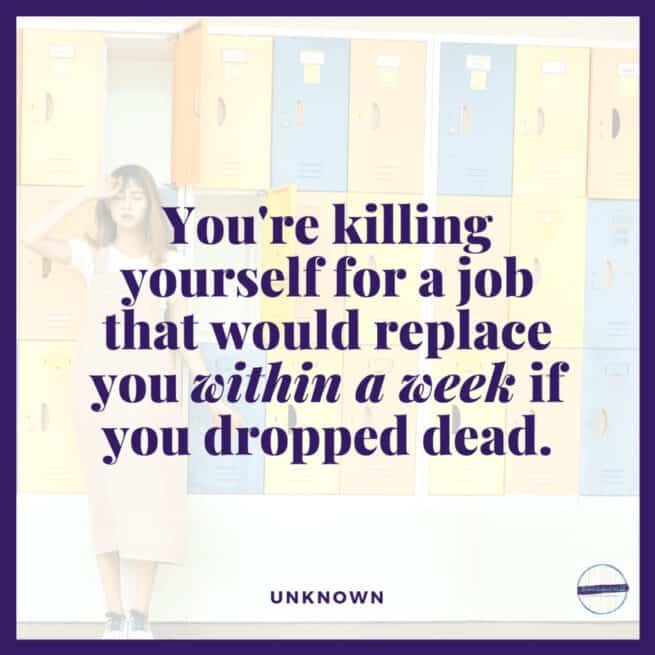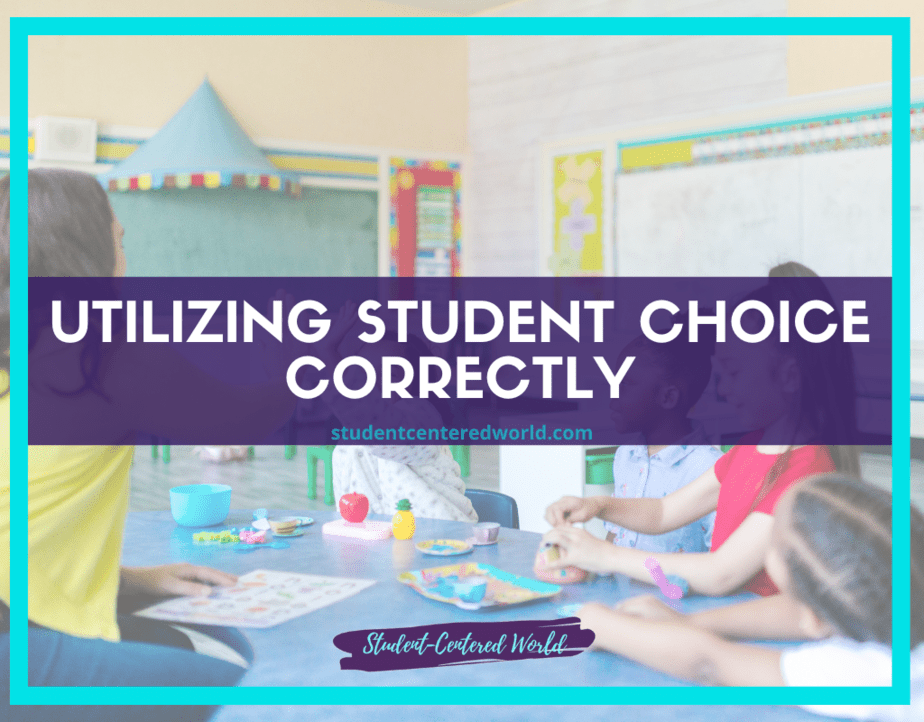Toxic School Culture: Addressing the Teacher Shortage Crisis
Listen to Episode 13 of the Student-Centered World Podcast above,
“What Do You Do With a Toxic School?”
I once saw on Facebook the plight of a teacher who had a total administrative, unannounced observation the morning after returning from winter break. This is the stuff of school culture nightmares.

That first day back from any break (let alone the morning) is all about recreating a routine, no matter the grade level. What were these school administrators thinking?
How often do you find yourself asking that exact question?
Hopefully, you’re in the position where you just read these nightmare scenarios on the internet but haven’t actually lived through them.
Or perhaps you’re like the rest of us.
Working in a toxic school culture sucks the life (and love) out of teaching faster than anything. Maybe you have a completely unsupportive administrative team, or perhaps opinionated parents have more pull than you do. There are one hundred different ways that you may find yourself working in a toxic school culture.
None of them are fun.
Signs of a toxic school culture
If you’re working in a toxic school environment, I don’t have to explain to you what that looks like. According to the ASDC (2019), there are 10 signs to look for:
- No clear sense of purpose.
- Hostile relations among staff, students, and parents.
- Emphasis on rules over people or mission.
- An absence of honest dialogue.
- More self-preservation than collaboration.
- Active back channels over formal lines of communication.
- Punishment instead of recognition, and rewards and behavior are motivated by the avoidance of punishment.
- A palpable lack of safety.
- A small group that controls the conversation.
- An absence of risk-taking
The last school district I worked in was so focused on implementing procedures properly, the kids were merely an afterthought…
I could have written this list myself based on the day-to-day interactions within the district and the school’s culture.
The final straw (after many red flags) for me was when I went to my administrator to tell him that a student had confided in me that he cut school and when he did, he found himself accidentally in a very compromising situation. My administrator’s reaction?
Did you write him up for cutting??
Literally, the LEAST important aspect of this entire conversation was the only one that sparked any interest.
I knew something had to give because this was not the school culture for me.
Why Toxic Schools are Leading to the Teacher Shortage
The national teacher shortage, especially in the United States, has reached critical levels and the impact is being felt across the entire education system. The shortage of qualified educators, particularly in subject areas like math and science, as well as in special education and bilingual education, has created a perfect storm in the teaching profession.
Recent data from the Bureau of Labor Statistics and the National Center for Education Statistics indicates that the teacher turnover rate is on the rise, leaving many public schools struggling to fill vacant positions. Teacher preparation programs are not producing enough new hires to meet the growing demand, and the number of people pursuing college degrees in education has dwindled in recent years.
Raise your hand if you’re surprised…..nobody? Read on…
Low teacher salaries, challenging working conditions, and a lack of support have deterred many potential educators, especially in high-poverty schools and rural areas. School districts, particularly in underfunded rural districts, have difficulty recruiting and retaining quality teachers. In many cases, long-term substitute teachers and underqualified educators have had to fill the gaps, which ultimately impacts the quality of education provided to students.
Furthermore, the pandemic exacerbated the issue, with many teachers and support staff opting for early retirement or pursuing other career opportunities. The teacher shortage crisis is not just affecting full-time teachers; it extends to all school employees, from bus drivers to support staff, creating a strain on public school systems and the overall quality of education.
To address this issue, state officials, the U.S. Department of Education, and school districts must work together to improve teacher recruitment and retention, providing better job satisfaction, competitive salaries, and professional development opportunities to reverse the trend.
What happens when the toxicity is too much in our schools?
The consequences of toxic school environments, combined with the national teacher shortage, are dire for our public education system. New teachers, already grappling with the challenges of the profession, are often placed in classrooms with underqualified educators and overwhelmed by overcrowded classes. Class sizes continue to grow, making it increasingly difficult for teachers to provide a quality education to all students.
Learning Policy Institute research shows that these conditions not only lead to low job satisfaction but also contribute to high teacher turnover rates, particularly in critical areas like math and science, as well as special education and second language instruction.
The impact of this crisis reverberates across all levels of education, from elementary school to middle school and high school. The U.S. Department of Education has noted the alarming number of open positions and teacher vacancies, especially in rural schools and low-income communities. The most recent data from the National Council on Teacher Quality reveals that many new teachers are not adequately prepared to tackle the challenges they face.
The shortage of quality educators affects the overall teacher quality and diminishes the potential for quality education for students, particularly in high-poverty areas. It’s imperative that district officials, in collaboration with the federal government, take substantial measures to address the toxicity within schools and provide more support, better teacher training, and competitive compensation to ensure an adequate number of well-prepared teachers to meet the needs of our educational system.
But what if you’re one of the teachers in the mix? What can you do when most of the issues plaguing your classroom are above your pay grade?
HOW TO COUNTER A TOXIC SCHOOL CULTURE
I was discussing my plight about my last school system with an educational colleague whom I had grown to respect (and who had no connection to my school community). After listening to my concerns, he looked me in the eye and said one simple statement.
“You’re not a tree.”
That may have been one of the most profound things I had heard about my career up to that point.
We often get so stuck in this cycle of despair and the feeling that we can’t do a darn thing about it. In actuality, there is a lot we can do about it because let’s be serious:

It’s not as easy as it is in other professions to find another job. Where I come from, you need to give 60 days’ notice to vacate a position or risk losing your teaching license. Schools are often eliminating positions instead of creating them and, of course, often when you have too much experience, you’re “too expensive” and won’t even be considered for an interview.
Puts you in a tough spot, doesn’t it?
Overall, you have three possible options if you are finding yourself in a toxic school culture and want to stay in education.

(This post may contain affiliate links that won’t change your price but will share some commission. As an Amazon Associate, I earn from qualifying purchases. Please read our disclosure policy for more information.)
1. Hope for Change
This is where most people get stuck. They feel like they are trapped in a situation over which they have no control and can’t do anything about. Maybe they’re too close to retirement or they can’t fathom having to commute to a new school. Regardless, they just go through the motions and grin and bear the toxic culture that surrounds them.
This is fine as long as you can sustain it.
Perhaps the issues at your school are truly something that you can close your door to, so to speak, and still make it through the day.
Your best bet is to try to get to the root of what you see as the issue of your specific toxic work environment. Is there one particular person who may be close to retiring? School culture in the building itself that can be tweaked in your own classroom? If you can keep under the radar OR do something to spark change, then this may be a good option for you.
If you decide to stay in the same toxic environment, it is important to stay very in tune with your mental health. Look for the red flags that show that you are, in fact, not okay. Early warning signs like a lack of patience consistently or avoiding difficult conversations with staff members are warning signs that your school’s culture is really starting to affect you in a negative way.
You need to remember, that the most important thing is you; if you are not on your game, then you will not be having a positive impact in the classroom. Student achievement and student learning will start to suffer, which will have an even bigger impact on your mental health. You may feel a sense of responsibility to stay for your students, but if your own experiences are not allowing you to be the teacher you know you should (and can) be, you may need to reassess.
If you do stick around, know that your school culture can change quickly with school leaders who have a common goal of school improvement and address issues with staff about the important things that matter to them. The toxicity won’t be there forever.
2. Change your path
There are multiple avenues in the educational system that aren’t necessarily in the classroom and look at school culture differently. Do some soul-searching and decide if one of them may be right for you.
Personally, this is the path I took. I began to love presenting workshops on Student-Centered Learning and so many of my colleagues were pushing me toward that as a new path. I was always frustrated that it took me so long to master student-centered learning because there was nothing out there that explained how to actually do it effectively…so I decided to be that person.
Starting my own business wasn’t necessarily the traditional way to go about this change, but I knew the universe was pushing me towards being a consultant and this seemed like the most logical next step. I now have the opportunity to see the “ah ha” moments with teachers and then watch as their students make positive changes with a specific behavior or academic success.
During COVID, I was able to listen to their main concerns and come up with a list of things to try. With teachers all over the world giving these a shot and coming back with what was working and what wasn’t, it gave me an opportunity that I wouldn’t have had if I was only working with the demographics in my own classroom. I was able to find long-term solutions that were working across the board.
It wasn’t easy leaving the classroom, or even my school, because of my students. Let me tell you something though….at the end of my last school year when I shared with them what I was planning to do, I couldn’t have had a bigger group of cheerleaders. There were lots of tears (on both sides) on the last day of school, but walking out the door and knowing that I had the full, uncontested support of the young adults whom I had the privilege of teaching…because they also believed in the methodology I was going to teach to other educators…was enough motivation for me to know I was making the right leap.
It’s not just consulting out there. There’s guidance, instructional coaching, or administration. There are all kinds of specialists and research opportunities and higher education. Really consider what might make you excited and then take the first step to figure out what you would have to do to get there.
3. Make like a tree…
You may love the classroom so much but just can’t take it where you are because of your school culture.
There’s no shame in that.
The last true option is to find a teaching position in another school. This looks different for different people. It may be a transfer within your district or into a completely different one. It may be a switch from private to public or rural to suburban.
It is up to you to decide what you want your future landscape to look like and then go for it.
Keep in mind that there is currently a teacher shortage, so there are certainly positions out there. However, make sure you’re researching the district first from every possible angle. The dominant voices are usually the disgruntled ones. Try to see what the school boasts, what parents are saying, and how the staff feels. If you find that some seriously talented teachers are peacing out, that might not be the best place.
If it seems that the general consensus is that there is a positive school culture, proceed. Don’t get lost in the idea that you want to get out of your school so bad that you’re willing to take any job that comes your way; that will have an even larger detrimental impact on your life.
The best thing you can do if you’re leaning this route is to get on social media with a teacher account. Twitter is huge with the “high up” educational folk and Instagram is like the teacher’s playground. LinkedIn is also a great way to make professional connections.
If you get yourself out there, it gives potential future employers an opportunity to see what you’ve got. Post activities in your classroom, educational articles you’ve found, and other school things that interest you to show how you teach on a daily basis.
This can have a huge impact on finding the right place for you. Just keep it positive.
If you need some help sprucing up your resume, check this out.
Check out the book Toxic Schools: How to Avoid Them & How to Leave Them (ad) for some guidance on this journey to a better school culture.
No matter what you decide to do, you need to make sure it’s best for you. This is YOUR life. Find joy in it.
(Pssst….snagged an interview? Here are 100 common teacher interview questions and answers to look through!)
The Last Piece to Consider
At the end of the day, it is up to you to decide if your toxic school culture is something you can bear to get through or if it’s just become too much. You 1000% need to put yourself first. If your mental and/or physical health is suffering because of your toxic school culture, you need to take a serious look inside to decide if it’s worth it.
Almost every single person I know has left education because of what it did to their mental and/or physical health. The common denominator in all of them? They had a toxic school culture and no avenue to help them navigate it. It turned into what had the effects of an abusive situation in their lives and it was just too much.
Every single story is unique and special and important and worth telling but they all end the same way: A toxic school culture out of their control was detrimental to his/her mental and/or physical health and had to leave in order to survive.
Watching colleagues go through this is another main reason I started Student-Centered World: to be another voice to help teachers navigate this terrain.
It is so so so so important and cleansing and therapeutic and absolutely necessary to do what you can to survive, but there comes a point where the only thing to do is leave. This time in your life should be treated as an active experience to learn from, not a time to be miserable.
You need to do what you can to protect yourself because your mental and/or physical health is your number one priority right now. If that means leaving, then you leave. There will always be another job out there for you with less toxicity in it if that’s what you want.
It’s going to be a bit of a logistical nightmare the first time you do it, but trust me if I am telling you this: It is so worth it.
The danger of toxic school culture is that it’s not always obvious and it’s certainly not something you can escape during the day. Do what you have to do to get your health back on track and stay strong! You can overcome anything with the right support behind you; it’s up to you to decide what path to take and what support to get.
This article was originally posted on January 8, 2020
References:
Carver-Thomas, Desiree, and Linda Darling-Hammond. “Teacher Turnover: Why It Matters and What We Can Do About It.” Learning Policy Institute, Aug. 2017, chrome-extension://efaidnbmnnnibpcajpcglclefindmkaj/https://learningpolicyinstitute.org/sites/ default/files/product-files/Teacher_Turnover_REPORT.pdf.
Epitropoulos, Alexa. “10 Signs of a Toxic School Culture.” ASCD, 1 Sept. 2019, www.ascd.org/el/ articles/10-signs-of-a-toxic-school-culture.
National Center for Education Statistics. “Forty-Four Percent of Public Schools Operating Without a Full Teaching Staff in October, New NCES Data Show.” IES/NCES, 6 Dec. 2022, nces.ed.gov/ whatsnew/press_releases/12_6_2022.asp.
National Center for Education Statistics. (2022). Teacher Turnover: Stayers, Movers, and Leavers. Condition of Education. U.S. Department of Education, Institute of Education Sciences. Retrieved [date], from https://nces.ed.gov/programs/coe/indicator/slc.
National Council on Teacher Quality (2020). Clinical practice and classroom management. NCTQ Teacher Prep Review: Clinical Practice and Classroom Management
Stop Driving the Teacher Struggle Bus
Are you struggling with student engagement, apathy, or keeping your class on track?
💫💫 There’s hope! 💫💫
Join my free teacher workshop “Choosing Choice” and in just 60 minutes, you’ll craft a practical plan to revitalize your teaching. Discover the magic of student choice in boosting engagement, gain quick implementation ideas, and explore strategies for year-long success.
Unlike overwhelming workshops, my approach guides you in real-time, providing more classroom options, reducing stress, and giving you more personal time.
Plus, you’ll earn a 1-hour professional development certificate and have 7 days of access.
Don’t miss this chance to transform your teaching; click below to secure your spot now!








8 Comments
Whiting Wicker
This happened to me at Sunridge Middle School, Winter Garden FL 2017-2018. And the principal became principal of the year. The school administration told me its goal was to protect its reputation. I countered that it should be enabling students to become true lifelong learners. I moved on to a university teaching environment where teachers aren’t harassed.
Mekila Jones
Hello, I am not a teacher but I’m in desperate need and direction on what to do at my children’s school. We moved here a little over two years ago and it’s been non-stop of harassment, bullying from staff & some teachers, verbal abuse, and the list can literally go on. My kids have never had any issues at other schools except this one. My youngest is on a IEP and the school somehow let it slip through the cracks and my child wasn’t receiving the help that was needed, until I found out about it. He’s been suspended for play wrestling with his friends out on recess. for 8 days! A teacher threw his stress ball in the garbage. He’s constantly getting harassed by certain staff and teachers. He has over 50 referrals that do follow him into high school. The write ups are mostly for extremely minor petty situations. I’ve had to take my son into the doctors because he’s been so stressed out it’s causing him to have headaches. At one point before I found out all this was going on. My child was completely shut down, I couldn’t figure out what was going on with him until he finally told me. I don’t know what to do at this point. It’s extremely exhausting and I’ve had several meetings with the principal. However, she’s part of the problem! Not only for my children but the children of this town! I know my kids are not the only ones. I feel so helpless for them. I know there is a shortage of staff here, and most the kids come from a background of parents who are only Spanish speaking and due to their status and circumstances nothing is ever said. There is so much more! But if anyone knows where or who I can go to.. this school needs change and help for the sake of these children’s future. 🙏🏽
About the Author: Jenn Breisacher
It sounds like there are a lot of layers here. Do you have an IEP written? If so, that is legally binding and must be followed. Also, document, document, document. There are many organizations that can help from the parental side of this to make sure everything is being acted on as it is meant to.
Jessica Gasho
Contact the department of education for your state! I’m a special education teacher and you have right, as well as your child! Report them! Gather proof. Right down everything with dates, if you have them.
Mekila Jones
Btw there are some amazing teachers there but I also feel they can’t speak up because there’s only one middle school and one high school. I wish there can be a change in the whole system for everyone.
Jacqueline Blinn
I have something to add similar but different. Please email me. I would love to correspond with you on this matter.
Beth
I wish that I had found this article about four years ago. I had about 26 years in higher ed and public school when I began teaching at a 9th grade center that was tantamount to a war zone. I had NEVER experienced anything like that before in all of my years in education and I’m still working through it! I was FIRED for poor classroom management skills (allegedly) but I know it was because I wasn’t about tolerating the abuse and I had to go. I wanted to leave anyway, and have worked at some really wonderful private schools since. I think my problem was not acknowledging that I had been in a war zone and once I left I didn’t “debrief”, as soldiers do. I have had a difficult time making the transition from approaching work from going into a war zone every day, activating the “fight, fight or freeze” impulse to where I am now, getting up calm and happy and peaceful and going in to a teaching situation where the students are kind, polite and eager to learn. That job was a hard, traumatic lesson that I would’nt wish on my worst enemy.
Jessica Gasho
This is exactly where I am now. Working in a toxic work environment where the principal rarely speaks to me but somehow magically hears stories from somewhere. He never talks to me about the situations that “are brought to his attention.” When asked for clarification, he says, “Off the top of my head, I can’t think of one.” That’s straight up horse manure. I’ve applied for other positions in District and outside of the district but no luck so far. I am literally at a training right now and have started having panic attacks about this next school year. I don’t see how I can continue on this path in this building. I am the breadwinner in the family so I have to have something lined up first before moving on. at the same time, I don’t think my mental health can take it anymore.